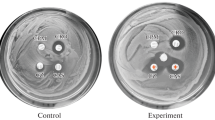Abstract
In 1984 the European Study Group on Antibiotic Resistance (ESCAR), which is made up of 29 laboratories in 12 European countries, consecutively collected gram-negative bacilli and staphylococci isolates from blood and using the microdilution method performed susceptibility testing with 11 beta-lactam antibiotics. A total of 2,578 isolates were collected; 68% were gram-negatives and 32% staphylococci.Pseudomonas spp. accounted for 12% of the strains,Enterobacter spp. 7%,Serratia spp. 3%, indole-positiveProteus spp. 1%,Citrobacter spp. andMorganella spp. 0.9% each. Strains with inducible beta-lactamases were detected by the cefoxitin disc diffusion method in 11% of all gram-negatives and in 67% of the relevant species. The production of inducible beta-lactamase was confirmed by elevated MICs to and decreased killing by piperacillin, cefotaxime and ceftazidime after induction of enzyme production with low concentrations of cefoxitin. This phenomenon was not observed with mecillinam or the new penem Sch 34343.
Similar content being viewed by others
References
Sykes, R. B., Matthew, M.: The beta-lactamases of gram-negative bacteria and their role in resistance to beta-lactam antibiotics. Journal of Antimicrobial Chemotherapy 1976, 2: 115–157.
Sanders, C. C.: Inducible beta-lactamases inEnterobacteriaceae andPseudomonas: problems for the new beta-lactam antibiotics. Infection Control 1984, 3: 287–310.
Sanders, C. C., Sanders, W. E., Jr.: Emergence of resistance during therapy with the newer beta-lactam antibiotics: role of inducible beta-lactamases and implications for the future. Reviews of Infectious Diseases 1983, 5: 639–648.
Olson, R., Weinstein, R. A., Nathan, C.: Broad spectrum beta-lactam resistance inEnterobacter: Emergence during treatment and mechanisms of resistance. Journal of Antimicrobial Chemotherapy 1983, 11: 299–310.
Normark, S., Lindberg, F.: Evolution of resistance to penicillin and cephalosporin antibiotics. Bio Essays 1985, 3: 22–26.
Murray, P. R., Granich, G.-G., Krogstad, D. J.: In vivo selection of resistance to multiple cephalosporins byEnterobacter cloaceae. Journal of Infectious Diseases 1983, 147: 590–596.
Weinstein, R. A.: Endemic emergence of cephalosporinresistantEnterobacter: relation to prior therapy. Infection Control 1986, 7, Supplement 2: 120–123.
European Study Group on Antibiotic Resistance (ESGAR): Susceptibility to beta-lactam antibiotics in septicemia isolates from 29 European laboratories. European Journal Clinical Microbiology 1987, 6: 460–466.
The Swedish Reference Group for Antibiotics: A revised system for antibiotic sensitivity testing. Scandinavian Journal of Infectious Diseases 1981, 13: 148–152.
Ericsson, H. M., Sherris, J. C.: Antibiotic sensitivity testing: Report of an international collaborative study. Acta Pathologia et Microbiologica Scandinavica (B) 1972, Supplement 217.
Sanders, C. C., Sanders, W. E., Jr., Goering, R. V.: In vitro antagonism of beta-lactam antibiotics by cefoxitin. Antimicrobial Agents and Chemotherapy 1982, 21: 968–975.
Dornbusch, K.: Assay of gentamicin concentration in serum specimens by microbiological and radio-enzymatic methods. Scandinavian Journal of Infectious Diseases 1977, 9: 227–231.
Dornbusch, K., Frölander, F., Cacciapuoti, A. F., Naples, L., Hare, R. S., Miller, G. H.: In vitro activity of Sch 34343 against gram-negative bacteria producing characterized beta-lactamases. Journal of Antimicrobial Chemotherapy 1985, 15, Supplement: 85–90.
Olsson-Liljequist, B., Dornbusch, K., Nord, C. E.: Characterization of three different beta-lactamases from theBacteroides fragilis group. Antimicrobial Agents and Chemotherapy 1980, 18: 220–226.
Towern, K. J., Massam, M.: Resistance to beta-lactamasestable cephalosporin antibiotics in strains ofEnterobacteriaceae andPseudomonas aeruginosa isolated from blood cultures. Journal of Antimicrobial Chemotherapy 1985, 16: 699–707.
Shearer, B. G., Legakis, N. J.:Pseudomonas aeruginosa: Evidence for the involvement of lipopolysaccharide in determining outer membrane permeability to carbenicillin and gentamicin. Journal of Infectious Diseases 1985, 152: 351–355.
Cullmann, W., Dick, W.: Evidence for nonspecific induction of beta-lactamase in overproducing variants ofEnterobacter cloaceae andCitrobacter freundii. European Journal of Clinical Microbiology 1985, 4: 34–40.
Moritz, V. A., Carson, P. B. D.: Cefoxitin sensitivity as a marker for inducible beta-lactamases. Journal of Medical Microbiology 1986, 21: 203–207.
Seeberg, A. H., Tolxdorff-Neutzling, R. M., Wiedemann, B.: Chromosomal beta-lactamases ofEnterobacter cloaceae are responsible for resistance to third-generation cephalosporins. Antimicrobial Agents and Chemotherapy 1983, 23: 918–925.
Livermore, D. M.: Class I beta-lactamase expression inPseudomonas aeruginosa and cephalosporin resistance. Lancet 1986, i: 450.
Williams, R. J., Livermore, D. M., Lindrige, M. A., Said, A. A., Williams, J. D.: Mechanisms of resistance to betalactam antibiotics in British isolates ofPseudomonas aeruginosa. Journal of Medical Microbiology 1984, 17: 283–293.
Sanders, C. C., Sanders, W. E., Jr.: Microbial resistance to newer generation beta-lactam antibiotics: Clinical and laboratory implications. Journal of Infectious Diseases 1985, 151: 399–406.
Curtis, A. C., Eisenstadt, R. L., Rudd, C., White, A. J.: Inducible type I beta-lactamases of gram-negative bacteria and resistance to beta-lactam antibiotics. Journal of Antimicrobial Chemotherapy 1986, 17: 51–61.
Marier, R. L., Marinaccio, A. T., Sanders, C. V., Aldtidge, K. E., Mitchell, J. W.: Susceptibility patterns of bacteria following therapy with piperacillin. Journal of Antimicrobial Chemotherapy 1982, 9, Supplement B: 85–87.
Kirkpatrick, B., Ashby, J., Wise, R.: Beta-lactamase and imipenem. Lancet 1986, i: 802.
Author information
Consortia
Rights and permissions
About this article
Cite this article
European Study Group on Antibiotic Resistance. Incidence of inducible beta-lactamases in gram-negative septicemia isolates from twenty-nine european laboratories. Eur. J, Clin. Microbiol. 6, 460–466 (1987). https://doi.org/10.1007/BF02013111
Issue Date:
DOI: https://doi.org/10.1007/BF02013111



